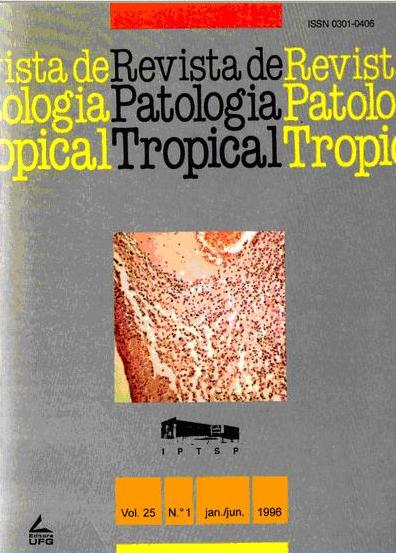FREQUÊNCIA DOMICILIAR DE CULICIDAE EM ZONA URBANA DE GOIÂNIA-GOIÁS-BRASIL
DOI:
https://doi.org/10.5216/rpt.v25i1.18477Abstract
Realizaram-se de janeiro a dezembro de 1992, capturas semanais em domicílio permanentementehabitado na periferia de Goiânia, onde foram capturados 329 exemplares de culicfdeos distribuídos por 12espécies e cinco géneros. Foi mais frequente Culex (Culex) quinquefascialus (Wiedtnann, 1828) (68,70%)seguido por Culex (Culex) quinqttefasciatus (Wiedmann, 1828) (68,70%) seguido por Culex (Culex) dolosus(Arribalzaga,1891) (14,28%); Aedes (Ochlerotatus) serrotas (Theobald, 1901) (4,55%); Culex (Culex)pilosus (Dyar & Knab, 1906) (3,34%); Coquilletiidia (Rhynchotaenia) juxtamansonia (Chagas, 1907)(3,04%); Anopheles (Nyssorhynchus) trianmtlatus (Neiva & Pinto, 1922) (2,43%); Anopheles(Nyssorhynchus) albitarsis (Lynch Arribálzaga, 1878); (0,61%) Anopheles (Nyssorhynchus) argyritarsis(Robineau-Desvoidy, 1827) (0,61%); Aedes (Ochlerotatus) scapularis (Rondani, 1848X0,61%);Coquilletíidia (Rhynchotaenia) venezueiensis (Theobald, 1912) (0,61%); Haemagogus (Conopostegus)leucocelaenus (Dyar & Shannon, 1924) (0,61%).A observação de espécies de interesse humano e animal, em domicílio habitado de Goiânia,sugere possíveis alterações em aspectos epidemiológicos de arboviroses.Downloads
Downloads
How to Cite
Issue
Section
License
The manuscript submission must be accompanied by a letter signed by all authors stating the full name and email address, confirming that the material has not been published or is under consideration for publication elsewhere, and agreeing to transfer copyright in all media and formats for Journal of Tropical Pathology. The authors will not be paid for published articles. They are solely responsible for the content of those articles, even if the Editor holds the right to adjust them to the norms of the journal.
The reviewers will not be paid for the peer review process.

